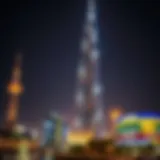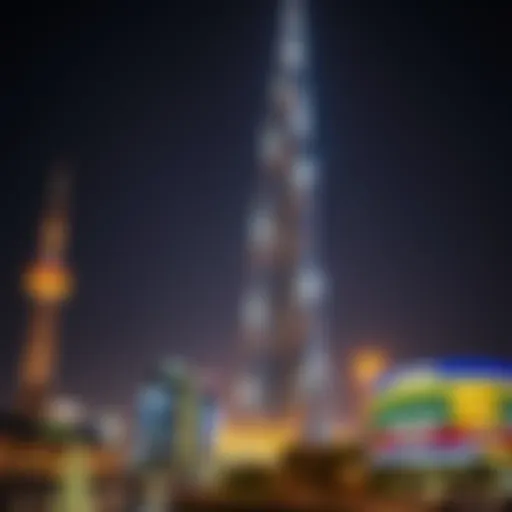Jubail Island Project: Balancing Development and Nature
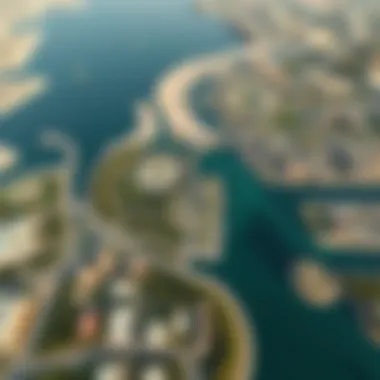
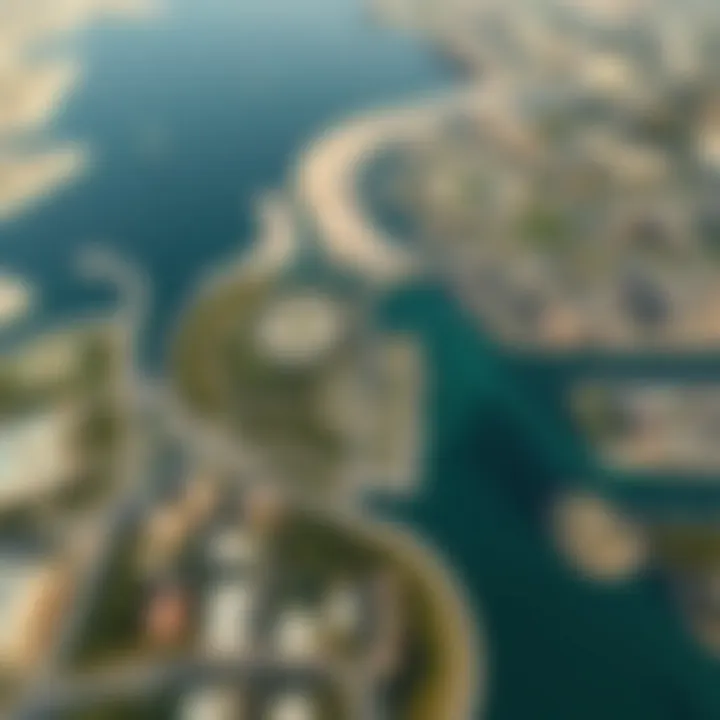
Intro
The Jubail Island Project is stirring the pot in Abu Dhabi, presenting an ambitious meeting point of nature and urban development. Nestled amid the Gulf's shimmering waters, this project isn't just about constructing buildings; it’s laying the groundwork for a future that anticipates environmental preservation alongside robust urban growth. The aim is to craft a living experience that naturally integrates with the surrounding coastal ecosystem, offering a slice of paradise that's hard to ignore.
At its core, this initiative revolves around several central ideas. First, it aspires to achieve a balance between the man-made and the natural, ensuring that urban living does not encroach upon the lush landscapes and rich biodiversity that characterize the region. Furthermore, it positions itself as a beacon for investment in sustainable practices, linking ecological stewardship with economic opportunity.
As the article unfolds, we’ll navigate through the various layers of this project. From looking at architectural innovations to exploring the socio-economic implications for the area, this examination aims to provide investors, homebuyers, realtors, expatriates, and developers with a thorough understanding of what the Jubail Island Project entails. It’s set to redefine real estate dynamics, potentially elevating quality of life while ensuring that environmental concerns remain front and center.
We will delve into market insights within the broader context of Abu Dhabi's real estate, analyze property buying considerations unique to this venture, and understand its implications for communities living in its shadow. Let’s embark on this journey, peeling back the layers to reveal not just a project, but a vision for a sustainable tomorrow.
Foreword to Jubail Island Project
The Jubail Island Project holds a pivotal role in shaping Abu Dhabi’s urban landscape and showcases a paradigm shift towards sustainable development. This initiative combines residential, commercial, and recreational spaces in a manner that respects and integrates the natural environment. Central to this project is the ambitious goal of harmonizing modern living with ecological considerations, which is of significant relevance not just locally but throughout the larger Middle Eastern context.
Overview of the Project Scope
At its essence, the Jubail Island Project stretches across an area of more than 1,500 hectares, promising to be a blend of vibrant communities and lush wilderness. The project's key objectives encompass the introduction of mixed-use developments, including residential units, commercial areas, and public spaces that cater to a diverse population. This scope isn't merely about construction; it’s about creating a lifestyle that fosters interaction among residents, encourages community spirit, and provides spaces for leisure and recreation.
The project's design reflects not only contemporary architectural trends but also ancient concepts of communal harmony and connectivity to nature. A variety of facilities such as parks, waterfront promenades, and cultural centers are incorporated to enrich the everyday experience of residents and visitors alike. Here's a snapshot of the scope:
- Residential areas designed to cater to diverse demographic groups, including expatriates, locals, and families looking for community-oriented living.
- Commercial hubs aimed at supporting local businesses, driving economic growth, and attracting international investments.
- An extensive network of cycling and walking paths linking various community amenities, thereby promoting a healthy lifestyle.
Importance of Jubail Island in Abu Dhabi's Development
The significance of the Jubail Island Project in the context of Abu Dhabi's development cannot be overstated. As oil revenues begin to stabilize, there's a noticeable pivot towards diversifying the economy and fostering sustainable tourism. The project, by design, is a response to this shift, demonstrating how urban development can coincide with environmental stewardship.
First, this initiative aligns with the UAE Vision 2021, which promotes sustainable growth, innovation, and environmental responsibility. By adopting smart development practices, Jubail Island is paving the way for future urban projects throughout the region. It enhances Abu Dhabi’s reputation as a forward-thinking city committed to quality of life and environmental conservation.
Further, the project acts as a catalyst for job creation and has the potential to invigorate the local economy by attracting real estate investments and tourism. The establishment of businesses and retail spaces aids in transforming the area into an economic powerhouse, boosting regional competitiveness while providing high-quality jobs for residents.
"The Jubail project aims to redefine residential and commercial living by merging urban convenience with nature's allure. Accessibility, community, and sustainability are at its core."
As the region continues to grow and evolve, the importance of striking a balance between urban expansion and ecological preservation is more pronounced. The Jubail Island Project serves not only as a blueprint for future developments but also as an inspiration, showing that it is possible to create something meaningful without compromising the natural environment. By embracing this holistic approach, Jubail Island stands as a promising indicator of Abu Dhabi's vibrant future.
Objectives and Vision of the Development
The Jubail Island Project stands as a beacon of modern urban planning and development, aiming to marry sustainability with visionary construction. Delving into its objectives and overarching vision, one can discern the careful thought that has gone into ensuring that the project not only meets immediate needs but also paves the way for future generations.
Addressing the core goals of the project, one can’t overlook the emphasis on sustainability. The creators of this initiative have recognized that as urbanization expands, so too must our efforts to safeguard the environment. Hence, the objectives include a strong commitment to green technologies and practices, which could significantly reduce the carbon footprint associated with large-scale developments. The vision is clear: create a thriving community without sacrificing the health of the planet.
The project also aims to enhance the quality of life for its residents. More than just a place to live, Jubail Island is envisioned as a hub of community interaction and cultural integration, promoting social well-being alongside economic growth. By fostering collaboration between the private and public sectors, the project seeks to nurture an environment where both community and economy can flourish.
Sustainability Goals
At the heart of the Jubail Island Project lies a commitment to sustainability, which reflects a growing understanding that modern development must coexist harmoniously with nature. This is not just about creating beautiful spaces but ensuring that they are future-ready.
Sustainable construction techniques are at the forefront, with innovative materials and methods being employed to minimize environmental impact. The landscape itself is designed to seamlessly integrate natural elements, with native plants utilized for landscaping to enhance local biodiversity. This aspect is crucial not just for aesthetics but also for reducing maintenance costs and resource usage over time.
Furthermore, the project encapsulates a vision for renewable energy, with solar panels and energy-efficient systems integrated into both residential and commercial spaces. This approach could appreciably decrease reliance on fossil fuels and bring about long-term cost savings for residents and businesses alike.
Community Integration and Collaboration
Essentially, the success of the Jubail Island Project hinges on community integration and collaboration. Developers are engaging with a variety of stakeholders, including local residents, businesses, and governmental bodies, aiming to craft spaces that are truly reflective of local needs and aspirations.
Public consultations have been a cornerstone of this process. Through forums and roundtable discussions, community voices are not just heard but actively shape the development trajectory. This level of engagement is vital to ensure that diverse perspectives inform design and functionality, ultimately creating a living environment that resonates with its inhabitants.
Moreover, interconnectivity is a key focus, as the design promotes seamless access to public transport and pedestrian walkways. Such features encourage social interaction and foster a sense of belonging among residents, making it more than just a residential area—it's a vibrant community where people can thrive together.
In summary, the objectives and vision that underpin the Jubail Island Project are ambitious yet attainable, rooted in sustainability and community engagement. These principles ensure that the development not only meets the challenges of today but is also a sustainable model for tomorrow. As investors and stakeholders look at the prospects, the focus on long-term viability becomes increasingly appealing.
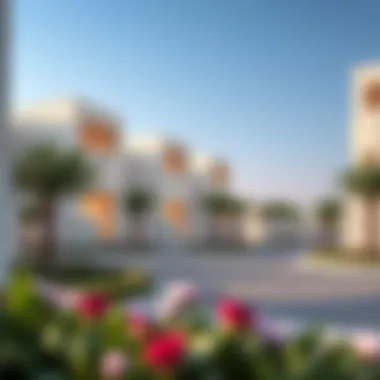
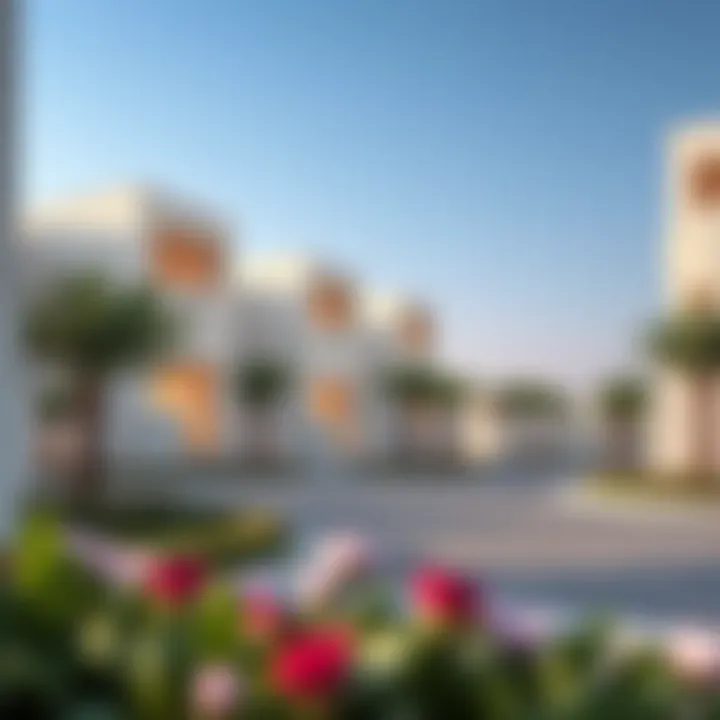
Architectural Features and Design Innovations
The architectural features of the Jubail Island Project stand as a testament to modern planning and design excellence. The aim is to create a harmonious balance between urban living and nature, providing unique spaces that reflect both functionality and aesthetic appeal. This section dives into the innovative architectural paradigms that define the project and how these contribute to the overall vision aimed at sustainability and community integration.
Contemporary Architectural Paradigms
Architectural design in Jubail Island draws from various contemporary trends. One prominent element is the emphasis on sustainable materials. These materials are not just environmentally friendly; they often provide better energy efficiency and reduce the carbon footprint of structures. For instance, the use of recycled, locally sourced materials minimizes transportation emissions and supports local industries.
Moreover, the designs incorporate open spaces, allowing for natural light and ventilation flow. This not only enhances the aesthetics but also contributes to a sense of well-being among residents. In addition, architects are strategically placing buildings to harness natural surroundings, creating views that capitalize on the scenic beauty of the island. The form and function blend seamlessly, ensuring spaces are both comfortable and inviting.
- Key aspects of modern architecture in the project include:
- Sustainable materials: Organic and local sources reduce environmental impact.
- Green roofs and walls: These features enhance insulation while producing oxygen.
- Smart technology integration: Offering practical solutions for energy consumption.
In retrospection, the architectural choice reflects the community's vision of what it means to live in a forward-thinking, environmentally aware community. The designs are not merely homes or offices; they represent a lifestyle that embraces both human and environmental health.
Integration of Nature and Built Environment
The integration of nature into the built environment is another hallmark of the Jubail Island Project. This approach highlights the intrinsic value of the surrounding environment, aiming to dissolve the barriers between human habitation and the natural world.
One exemplary feature of this integration is the extensive use of landscaped parks and gardens, strategically placed throughout the development. Such green spaces are vital; they provide residents with a natural retreat, improve air quality, and even serve as pathways for wildlife. These spaces are designed not only for recreation but also for promoting biodiversity, thus enriching the ecosystem.
In terms of urban design, walkable pathways connect various facilities, ensuring that residences, commercial areas, and leisure are accessible without the need for vehicles. This not only reduces traffic congestion but also encourages a more active lifestyle. Through this design, residents can enjoy a stroll or bike ride amid green vistas, further fostering a sense of community.
"Integrating nature into urban spaces is not just an aesthetic choice, it's a crucial step towards sustainable living and community health."
Additionally, water features are incorporated into the architecture, serving both functional and visual purposes. They not only provide aesthetic value but also play a role in cooling the environment, which can be particularly beneficial in Abu Dhabi's climate.
- In summary, integrating nature and architecture culminates in:
- Biodiversity support: Areas for native flora and fauna.
- Enhanced community engagement: Parks encourage social interaction.
- Visual and auditory benefits: Creating serene spaces that enrich everyday life.
Through these innovative designs, the Jubail Island Project embodies a future where architecture coexists with the ecosystem, forging a path for sustainable development.
Infrastructural Developments
The Jubail Island Project is more than just a picturesque landscape poised against the waters of the Arabian Gulf; it stands as a testament to innovative infrastructural development. The success of this project hinges on meticulously planned and executed infrastructure that serves both residents and visitors alike. This section delves into the transportation networks and utilities integral to the project, underscoring their significance, benefits, and overall impact on the community.
Transportation Networks
Effective transportation is the lifeline of any modern development, and Jubail Island’s transportation networks are designed with the sophistication of a finely tuned watch. The integration of roads, public transport, and pedestrian pathways showcases a commitment to accessibility and efficiency.
- Roads: The project's roads are designed to facilitate smooth vehicular movement while minimizing environmental impact. Thoughtfully crafted routes are in place to ease traffic and connect various sectors of the island seamlessly.
- Public Transport: There are plans for an efficient public transport system utilizing electric buses. This initiative aims to reduce the carbon footprint, ensuring that the development harmonizes with its environmental goals.
- Pedestrian Pathways: Emphasizing walkability, the project incorporates extensive pedestrian pathways. These are not merely functional but also aesthetically appealing, allowing residents to enjoy the lush surroundings and connect with nature.
As notable architect and urban planner, Jan Gehl, once said, "First life, then spaces, then buildings – the other way around never works.” The planning of transportation on Jubail Island reflects this philosophy, prioritizing the community’s needs.
Utilities and Services Infrastructure
When it comes to the utilities and services infrastructure, the Jubail Island Project is laying down a foundation that is as sustainable as it is efficient. The aim here is to provide essential services without compromising environmental integrity.
- Water Supply: Advanced systems for water management are implemented. This includes water recycling and desalination technologies which ensure that residents have consistent access to fresh water while conserving natural resources.
- Energy Infrastructure: The project aims for energy-efficient solutions, exploring solar energy harnessing and smart grids. Essentially, this means lower bills for consumers and a lighter environmental load.
- Waste Management Systems: Innovative waste management practices ensure that the island remains clean and environmentally friendly, with initiatives to encourage recycling and responsible waste disposal among residents.
All these elements create a conducive environment for living, working, and leisure on Jubail Island. The thoughtful combination of transportation networks and utilities reflects not just a functional approach but an aspirational outlook toward sustainable urban living.
"Infrastructure is not just the backbone of a community; it's the platform upon which dreams are built."
As the Jubail Island Project evolves, it is crucial for investors, homebuyers, and developers alike to recognize how these infrastructural developments can shape community dynamics and promote a higher quality of life. Understanding what lies beneath the surface—quite literally—will certainly enlighten stakeholders about the exciting potential the island holds.
Environmental Considerations


The environmental considerations surrounding the Jubail Island Project hold monumental significance, especially in a world increasingly focused on sustainability. This initiative isn’t just about constructing buildings or laying roads; it's also about forging a model for future developments that marry economic growth with the need for ecological responsibility. The project's design inherently includes strategies that aim to protect and enhance the natural environment, ensuring that the local ecosystem can flourish alongside urban expansion.
One of the core components of this focus on environmental considerations is the meticulous approach to ecological impact assessments. Through these assessments, the project aims to quantify potential environmental effects and develop mitigation strategies that prioritize the health of the surrounding landscapes. By analyzing soil conditions, local biodiversity, water usage, and carbon footprints, the developers intend to create a framework that supports both growth and conservation efforts.
Incorporating these assessments not only helps in minimizing adverse impacts but also strengthens community relations. Residents and potential investors are more likely to engage with projects deeply committed to sustainable practices. Additionally, ecological awareness can lead to a stronger brand for the Jubail Island Project, enhancing its desirability in a market that increasingly values sustainability.
Ecological Impact Assessments
Ecological impact assessments (EIAs) are a cornerstone of responsible development planning. In the context of the Jubail Island Project, EIAs serve as the locomotive driving the initiative's environmental stewardship. These comprehensive analyses go beyond mere compliance with local regulations; they embody a commitment to responsible development. By evaluating the potential impacts on flora, fauna, and local water systems before any physical changes begin, stakeholders can develop actionable strategies to mitigate negative effects.
Moreover, EIAs generate relevant data that informs decision-making processes, which is especially beneficial in the planning and execution phases of largest developments. Stakeholders, including government authorities and environmental organizations, often review these assessments. This layer of oversight helps ensure that the project aligns with broader ecological goals of the region, promoting transparency and fostering trust within the community.
Incorporating feedback from public consultations also enriches the process. Communities often have deep ties to their local environments; therefore, their insights can illuminate issues that statistical data may overlook. Ultimately, the rigorous application of EIAs promotes a vision where development serves human needs while also upholding the natural balance.
Biodiversity Conservation Efforts
Another vital aspect of the Jubail Island Project is its focus on biodiversity conservation. Protecting the region's biodiversity is not just an obligation but an opportunity to create unique and resilient ecosystems that can thrive amid urbanization. The project planners are looking at how to integrate living spaces with natural habitats, fostering an environment where wildlife and humans coexist harmoniously.
Actions such as restoring native vegetation, creating green corridors, and installing wildlife-friendly infrastructures are imperative to enhance local habitats. This approach not only provides aesthetic value but actively contributes to the ecological health of the area. By ensuring that native species thrive, the site can serve as a sanctuary of biodiversity, safeguarding against the effects of urban sprawl.
Also, recognizing local species and understanding their roles in the ecosystem is crucial. Educational programs embedded within the project further support community involvement in conservation efforts. Encouraging residents to participate in planting campaigns or conservation workshops helps kindle a sense of stewardship and responsibility toward the environment.
“Once you've seen the wonders of biodiversity, it becomes clearer that protecting these ecosystems is a path to preserving our own future.”
In this regard, the Jubail Island Project stands as a beacon of modern development principles, where economic interests and ecological wellbeing converge, setting a precedent for future developments in not just Abu Dhabi but potentially worldwide.
Socio-Economic Implications
The socio-economic implications of the Jubail Island Project are broad and significant, as they encompass various facets from job creation to shifts in the real estate landscape. Through this initiative, Abu Dhabi is not only aiming for physical transformation but also nurturing an ecosystem that could revitalize the local economy and improve quality of life. The community's overall welfare hinges on understanding these implications, making it a critical focal point of this exploration.
Job Creation and Economic Growth
A cornerstone of the Jubail Island Project is its potential to generate a plethora of jobs, providing real opportunities to various segments of the population. With the construction phase itself requiring skilled and unskilled labor, numerous employment channels open up even before the development officially completes. This initial boost can help absorb unemployment gaps, fulfilling immediate economic needs.
After completion, there’s a forecasted demand for services and infrastructure, which translates to ongoing job creation in areas like healthcare, education, retail, and hospitality. For instance, the employment landscape might see an uplift with more hospitality jobs arising due to increased tourism as the island draws visitors eager to experience a blend of urban living and tranquility. The benefit extends into supporting roles, creating a community that thrives on diverse job opportunities.
Notably, the ripple effects of this job creation can spur economic growth far beyond Jubail Island. Local businesses can mature and find enhancing opportunities with increased footfall and demand for products and services that cater to new residents and visitors alike. The ancillary sectors—construction suppliers, transportation services, and even local artisans—stand to gain significantly from the economic ecosystem fostered by this project.
Residential Market Impact
The repercussions of the Jubail Island Project on the residential market are poised to be momentous. As the development unfolds, new residential properties will emerge, enticing both investors and homebuyers. The prospect of modern amenities, sustainable living, and an environment rich in green spaces adds a compelling allure to potential buyers seeking a balance between urban conveniences and serene landscapes.
Moreover, this surge in supply can actively influence property values across Abu Dhabi. An agent's perspective might identify an uptick in market activity, as buyers will likely be drawn to properties that boast proximity to both nature and the bustling urban environment of Abu Dhabi. With meticulous planning incorporating parks, leisure zones, and community centers, the island is likely to become a desirable place for families and expatriates alike, ultimately reshaping housing demand in the region.
"The impact on the housing market isn’t just confined to Jubail Island. It sets a precedent, influencing trends through surrounding areas and potentially rejuvenating long-established neighborhoods."
Furthermore, increased consumer confidence and favorable economic conditions can drive more buyers to enter the market. Increased demand generally leads to a healthier, more dynamic residential sector—paving the way for sustained growth. Investors should keep a keen eye on how markets adjust and adapt as more data emerges from the early stages of this project.
Investment Opportunities in Jubail Island
Jubail Island is carving a niche for itself in the ever-evolving landscape of Abu Dhabi. The project's investment opportunities are undeniable and multifaceted, appealing to a diverse array of investors, from individual homebuyers seeking a serene environment to large-scale developers aiming to make their mark in the region. This section delves into the specifics of these opportunities, emphasizing the potential benefits and considerations for those looking to invest in this transformative development.
Real Estate Prospects
With its unique combination of urban living and proximity to nature, Jubail Island provides ample real estate prospects that are difficult to find elsewhere.
- Unique properties: The island’s real estate market features an eclectic mix of villas, townhouses, and apartments that cater to various tastes and preferences. Investors can tap into a market that promises not just housing but a lifestyle.
- Appreciation potential: As Abu Dhabi continues to grow, the demand for quality housing is set to rise. Areas like Jubail Island are likely to see significant property appreciation, making them attractive to both first-time buyers and seasoned investors.
- Sustainable living: The emphasis on environmental sustainability adds a layer of appeal. Many modern buyers are drawn to eco-friendly properties and neighborhoods. Living in a place that prioritizes sustainability is not just attractive—it’s a growing necessity in today’s world.
Moreover, the master plan of Jubail Island incorporates essential amenities such as schools, shopping centers, and recreational facilities, which collectively enhance the attractiveness of the location. Homebuyers and investors recognize that convenience can boost property values, creating a win-win scenario.
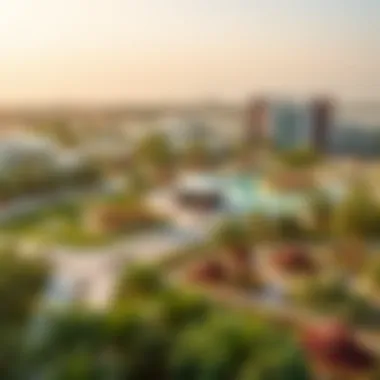
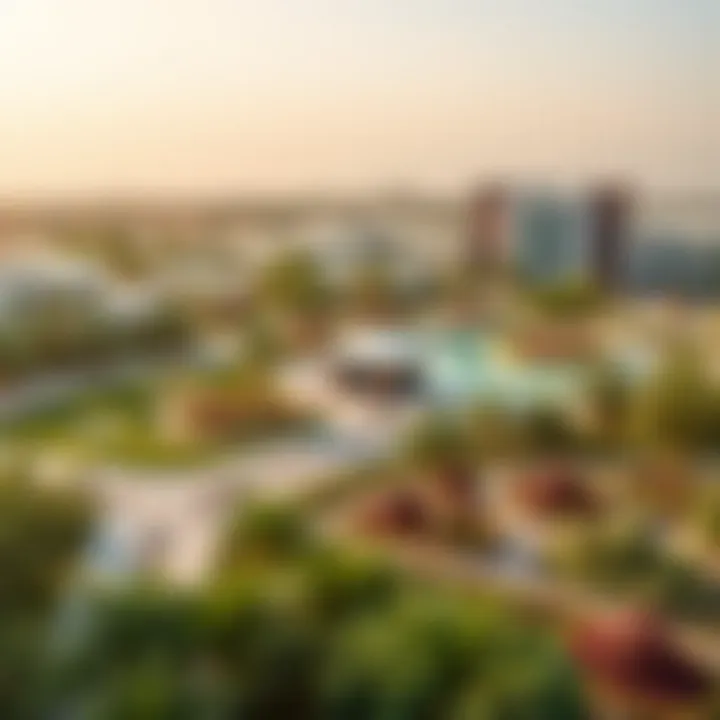
Commercial Ventures and Economic Incentives
In parallel with residential opportunities, commercial ventures in Jubail Island present remarkable incentives for business-minded individuals.
- Strategic location: Positioned at a prime location in Abu Dhabi, businesses located in Jubail Island benefit from excellent connectivity to major transportation routes and urban hubs, which can significantly amplify their customer reach.
- Support from local government: The Abu Dhabi government is keen on promoting growth in economic zones, offering various incentives such as reduced business costs, tax exemptions, and simplified regulations, further appealing to entrepreneurs and companies.
- Diverse business opportunities: From retail spaces to office buildings, the variety of commercial properties available allows entrepreneurs to explore numerous business ideas and concepts. Whether it's a boutique shop, a trendy café, or corporate offices, the possibilities are vast.
"Investing in Jubail Island is not just about purchasing property; it's about becoming part of a vibrant community and a visionary project that promises sustainable growth."
In summary, Jubail Island emerges as a beacon of investment opportunities that promises not only substantial returns but also a chance to be part of a progressive movement. With the urban-development strategy in play and the growing emphasis on sustainability, putting money into this venture today could mean reaping benefits for years to come.
Community Engagement and Social Responsibility
Community engagement and social responsibility are vital pillars in the success of the Jubail Island Project. These components not only enhance the project’s public image but also ensure that the development aligns with the needs and values of the community it affects. By prioritizing engagement and responsibility, the project aims to integrate local perspectives into its framework, fostering a sense of belonging and ownership among residents.
The very essence of community engagement lies in understanding and involving those who will call this place home. Engaging with residents and stakeholders allows for a two-way dialogue that enhances the decision-making process. It is not merely about informing the public but about active participation in shaping their environment.
Public Consultations and Feedback Mechanisms
Public consultations serve as a critical bridge between the project developers and the community. Periodic town halls, forums, and workshops provide platforms for residents to voice their concerns and expectations. These gatherings lay the groundwork for transparent communication, which is essential for cultivating trust. Feedback mechanisms such as surveys and suggestion boxes further empower the community by offering them channels to express their thoughts directly.
In essence, these interactions can lead to more refined planning and implementation. As stakeholders see their suggestions translated into actions, it reinforces their commitment to the project and enhances overall satisfaction. This dynamic exchange helps mitigate any potential conflicts or misaligned expectations, allowing for smoother project progression.
Commitment to Local Culture and Heritage
The commitment to local culture and heritage sets Jubail Island apart in its developmental philosophy. Recognizing that communities are built on shared history and traditions, the project developers are tasked with ensuring that these elements are preserved and celebrated. This commitment might manifest in the incorporation of architectural styles that resonate with the local environment, or events that celebrate cultural practices unique to the region.
By honoring the local identity, the project not only enhances the livability of the area but also attracts residents who value cultural integrity. This approach leads to a richer community experience, encouraging longer-term investment in the area. The challenge, however, lies in striking a balance between modern urban needs and historical preservation, but with careful planning, it can serve as a model for future developments.
Challenges and Controversies
The Jubail Island Project, while being a beacon of hope for sustainable development within Abu Dhabi, has not been without its share of obstacles and criticisms. Addressing the barriers and controversies surrounding the project is crucial. It sheds light on not only the project’s resilience but also the various stakeholders involved, including investors, homebuyers, and the broader community that is directly or indirectly affected.
Developmental Hurdles and Solutions
In the midst of grand aspirations, several developmental hurdles have surfaced.
- Environmental Concerns: One of the most prominent challenges stems from ecological impacts. The construction and urbanization processes can disrupt local ecosystems. To mitigate this, the developers have begun incorporating adaptive measures for environmental protection. This includes improved waste management systems and the establishment of green buffers.
- Financial Viability: Like any large-scale project, securing funding poses a challenge. Investors often weigh risks against potential returns, especially given fluctuating market conditions. To address this, project leaders are actively engaging with potential investors, showcasing feasibility studies and emphasizing the long-term benefits of sustainable investments.
- Regulatory Approvals: Navigating through bureaucratic processes and securing the necessary permits can be a slow and tedious affair. In response, the project has fostered close partnerships with governmental bodies, ensuring that compliance is prioritized.
Despite these hurdles, a proactive approach entailing adaptable strategies shows a promising path forward. It emphasizes the importance of being flexible, making adjustments based on real-time feedback and environmental considerations.
Public Perception and Critiques
Public sentiment often holds a mirror to the perceived value and benefit of initiatives like the Jubail Island Project. Understanding these perceptions is vital for fostering community support and encouraging investment.
- Skepticism About Sustainability Claims: While the project touts its commitment to sustainability, some community members feel skeptical. They demand transparency in how these claims are substantiated. Engaging the public in decision-making processes, through forums or consultations, could counter this skepticism and demonstrate genuine commitment to community integration.
- Gentrification Fears: Critics raise concerns that the development may lead to an influx of wealthier residents and ultimately drive up local property prices. This shift could displace long-time inhabitants, creating social tensions. To address this, developers are encouraged to incorporate affordable housing options into their plans, thus maintaining a balance within the community structure.
- Cultural Resilience: The project must navigate between modernity and the preservation of local traditions. Some argue that new developments may potentially dilute local culture. Promoting heritage conservation alongside contemporary designs could bridge this gap, ensuring both progress and the enrichment of local identity.
Future Outlook for the Jubail Island Project
The future outlook for the Jubail Island Project is a pivotal element that reflects its lasting impact on Abu Dhabi's urban landscape. As the project nears completion, it promises not just to enhance property values but also to set benchmarks in sustainable development. With its integrated approach, the vision extends beyond mere infrastructure; it encompasses the well-being of the surrounding environments. There’s a keen focus on sustainability, community well-being, and economic revitalization.
Long-term Vision and Development
The long-term vision for Jubail Island signifies a blend of ambitious planning and a commitment to environmental preservation. This vision does not exist in isolation but rather operates within a framework of ongoing dialogue with urban planners and environmentalists to ensure a harmonious coexistence of nature and urban life. The hopes are pinned on a multi-phased approach, allowing for adaptation based on community needs and environmental assessments. Here are some specific highlights:
- Mixed-Use Development: Engaging different functionalities such as residential, recreational, and commercial strategies, fostering a vibrant community atmosphere.
- Green Spaces: An integral part of the design, emphasizing parks and nature reserves that promote biodiversity.
- Smart Technologies: Incorporating cutting-edge technologies for monitoring and efficiency in utilities, traffic, and pedestrian pathways further bolsters the project's smart-city vision.
In the long run, stakeholders anticipate a seamless blend of urban and natural elements, elevating the social fabric and economic viability.
Potential Evolution in Urban Planning
As the dust settles and the landscape evolves, the Jubail Island Project could serve as a benchmark for future urban planning initiatives within the UAE and the broader region. The potential evolution includes:
- Sustainable Urban Practices: Setting a standard for eco-friendly building practices that can inspire smaller projects elsewhere, showcasing the importance of reducing carbon footprints.
- Collaboration with Developers: Engaging local and international developers ensures not just investment but also the infusion of innovative ideas and technologies.
- Resilient Infrastructure: Emphasizing climate-resilient architectural designs that respond to changing weather patterns and environmental challenges.
“The Jubail Island Project is not just about land development; it's about cultivating a legacy that harmonizes the aspirations of the inhabitants with the grace of nature.”








